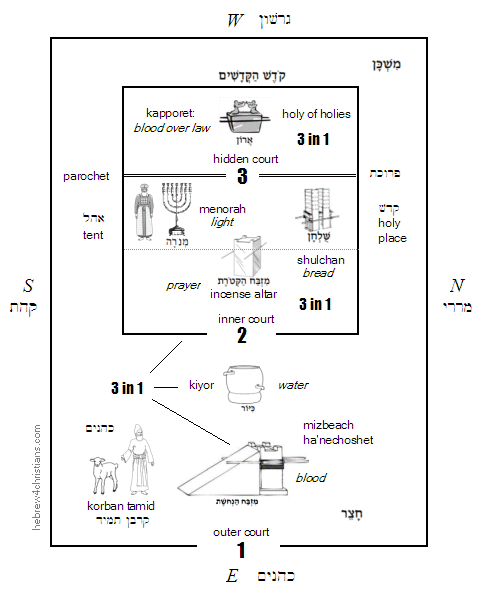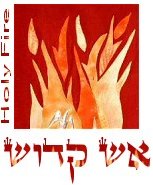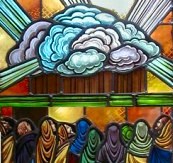|
|
 |
 |
 |
 |
|
Weekly Torah Reading
|
|
|
|
Parashat Pekudei ("accounting of")
|
|
|
Click on the links to display the Scriptures:
|
|
|
|
 |
 |
 |
|
Torah Reading Overview
|
|
|
|
This short portion (the last of the Book of Exodus) is read with parashat Vayakhel during non-leap years (i.e., in years when there is no additional month of Adar inserted into the calendar).
Moses first made an accounting of (פְּקוּדֵי) the materials that were donated for the construction of the Mishkan (i.e., Tabernacle). Betzalel and Oholiav then made the Priestly garments: the ephod (apron), choshen (breastplate), ketonic (cloak), crown, hat, tunic, sash and breeches, all according to the specifications given to Moses on the mount (and also given in Parashat Tetzaveh).
The parashah begins:
|
|
|
 |
 |
|
"These are the records of the tabernacle, the tabernacle of the testimony, as they were recorded at the commandment of Moses, the responsibility of the Levites under the direction of Ithamar the son of Aaron the priest." (Exodus 38:21)
|
 |
 |
|
All of the components of the Mishkan are brought to Moses, who then erects it and anoints it with the holy anointing oil. Aaron and his four sons are initiated into the priesthood. The parashah concludes with the cloud of glory appearing over the Mishkan, signifying that the LORD's Presence has come to dwell within it.
|
 |
 |
 |
|
The Priestly Garments
|
|
|
|
Only descendants of Aaron were allowed to wear the priestly garments (a Levite or regular Israelite could not do so), and only while performing avodah (service) in the mishkan. A regular priest (kohen hedyot) had four required garments, whereas the High priest (kohen gadol) had eight.
All kohanim (regular priests) wore: 1) the ketonet -- a full length tunic or long shirt; 2) michnasayim -- short pants; 3) migba'at -- a band of white linen wound into a pointed turban; and 4) avnet -- a (very!) long sash that was wound above the waist. The avnet was over 40 feet in length!
|
|
|
 |
 |
|
In addition to these, the Kohen Gadol wore: 5) the efod, an apron-like garment (tied in the front) made of blue, purple and red-dyed wool, linen and gold thread; 6) the choshen mishpat, a breastplate with a pouch that contained twelve precious stones inscribed with the names of the twelve tribes of Israel; 7) a me'il -- a coat of blue wool, with golden bells and decorative pomegranates on its hem; 8) the tzitz -- a golden headband bearing the inscription Kodesh la-Adonai - "Holy to the LORD."
Notice that neither the regular kohanim nor the Kohen Gadol wore shoes or slippers! In other words, they served in the mishkan (and later at the Temple) barefoot.
According to Jewish tradition, the bells were worn on the High Priest's coat in order to "scare off" any holy angels that were serving in the Kodesh section of the mishkan (apparently God did not want any of the angels there to be critical of the High Priest as he performed his duties). Another tradition states that the bells were used so that the Israelites would remember to pray for the priest as he served on their behalf.
The choshen or breastplate of the High Priest is also described in this portion of Torah. This sacred vestment was worn over the ephod (linen apron) and contained two special gemstones called the urim v'tummin ("lights and perfections"; Ex. 28:30; Lev. 8:8; Num. 27:21; Deut. 33:8). These stones were used to discern the will of God in some cases (1 Sam. 14:41; 28:6; Ezr. 2:63; Neh. 7:65). Some have claimed that the Shekhinah would cause the urim and tummim to light up and shine upon the avnei choshen (the 12 gemstones in the choshen that represented the 12 tribes of Israel). Since each stone was inscribed with a name of a tribe of Israel, the letters illuminated on the choshen would reveal an answer to a question posed by the High Priest.
|
 |
|
 |
 |
 |
|
 |
|
|
|
Avnei Chosen
|
|
|
|
The choshen was arranged with four rows of three stones. Each stone was inscribed with six letters representing a name of a tribe of Israel (for a total of 72 letters).
- Row 1: Reuben (ruby), Simeon (topaz), and Levi (garfinkel)
- Row 2: Judah (carbuncle), Issachar (sapphire), and Zebulun (pearl)
- Row 3: Dan (jacinth), Naphtali (agate) and Gad (crystal);
- Row 4: Asher (emerald), Joseph (onyx), and Benjamin (yashneh- an unknown stone).
According to the Gemara (Sotah), the "shamir" was a miraculous worm, as small as a grain of barley, that was used to engrave the names of the tribes on the stones.
Believers in the Mashiach Yeshua are likewise appointed to be a kingdom of priests (1 Pet 2:9) and have direct access to the Ruach HaKodesh (Holy Spirit) to discern the will of God. We do this through faith, asking the LORD for wisdom, and trusting in His Light and Perfection to guide us into all truth (John 16:3).
|
|
|
When was the Mishkan Dedicated?
|
|
 |
 |
|
The LORD commanded Moses to assemble the Mishkan on "the first month in the second year [from the date of the Exodus], on the first day of the month" (i.e., on Nisan 1, or Rosh Chodashim). Since Moses gave the commandment to begin building the Tabernacle on the day after Yom Kippur (i.e., Tishri 11), this implies that it took less than six months for Betzalel and his team to create the Tabernacle and all its furnishings. According to Pesikta Rabbati, the Mishkan was actually completed on Kislev 25, but God did not want it put up until Nisan 1 (to commemorate the birth of Isaac). The month of Kislev was thus deprived, and God said: "I must compensate it." How did God compensate the month of Kislev? With the dedication of the Temple by the Hashmoneans (on Chanukah). Note further that the Mishkan was consecrated for seven days before God manifested His Presence there. During each of the "seven days of consecration" (beginning on Adar 23) Moses set up the entire Mishkan and offered sacrifices every morning and then pulled it down. On the eighth day (i.e., Nisan 1) he put it up but did not dismantle it again. Moses then anointed all its components with the sacred anointing oil called shemen ha-mishchah (note that the word "mishchah" (מִשְׁחָה) comes from the same root as "Messiah" (מָשִׁיחַ), indicating that the Mishkan would foreshadow God's plan of redemption given in Yeshua) and then formally initiated Aaron and his four sons into the priesthood. The Divine Presence - manifest as the Shekhinah Cloud of Glory – then filled the Holy of Holies in the Tent of Meeting.
 |
|
 |
 |
|
How many people left Egypt during the Exodus?
|
 |
 |
|
Our portion this week gives us a clue as to the number of people who left Egypt during the Exodus. According to the sages, over two million people were present at the time the Mishkan was filled with the Divine Presence (less than one calendar year after the Exodus on Nisan 15). They determine this number by the account of the weight of the silver used for the sockets (adonim) of the Mishkan (Exod. 38:25). As mentioned above, a half-shekel tax was imposed on all males from the age of 20 years and up (Exod. 30:13-16). Moses recorded the weight of the silver to be "a hundred talents [i.e., kikars] plus 1,175 shekels. If one kikar equals 3,000 shekels and there were 100 kikars, this amounts to 300,000 shekels. We then add 1,775 to yield 301,775 and multiply by 2 to result in 603,550 men aged 20 or more (see Exod. 38:26). Assuming these were married men with 2 or more children, the total number of people represented by the shekalim reaches two million.
|
 |
 |
|
Why is the Tabernacle called the Mishkan?
|
 |
 |
|

The word mishkan comes from the Hebrew word lishkon, meaning to rest, and was considered to be the resting place of the Shechinah (presence of the LORD). The mishkan is also called mishkan ha'eidut - the mishkan of testimony - since it testified of God's forgiveness of the Jewish people for their idolatry with the egel maseikhah (Golden Calf).
|
 |
 |
|
The Mishkan and Creation
|
 |
 |
|
The Sages sometimes say that the building of the mishkan is an analogue of God's creation of the universe itself:
|
 |
|
|
|
Creation of the World
|
Building of the Mishkan
|
|
1st Day - Heavens spread as a curtain
|
Curtains over the mishkan
|
|
2nd Day - Upper/lower waters separated
|
The parochet (curtain) separates the
kodesh (Holy Place) from kodesh hakodeshim (Holy of Holies)
|
|
3rd Day - Lower waters gathered
|
Gathering of the people; the kiyyor (bronze laver)
|
|
4th Day - Creation of sun, moon, stars
|
The light of the menorah
|
|
5th day - Creation of fish and birds
|
The keruvim (cherubim)
|
|
6th Day - Creation of Adam in Eden
|
Dedication of Aaron as High Priest
|
|
7th Day - God rested
|
Shabbat; anointed oil upon mishkan
|
|
 |
 |
|
The Mishkan and Mikdash
|
 |
 |
|
With the mishkan in place, the book of Exodus comes to a close.
Since today there is no physical Mishkan (or Temple), Avot 3:6 is often quoted to encourage Jews to seek the divine presence:
|
|
|
 |
 |
|
"If ten sit and engage in Torah study, the Shekhinah Divine Presence abides among them, as it is said, "God stands in the congregation of God" (Psalm 82:1). How do we know that it applies to five? Because of the verse "He has founded his bunch on the earth" (Amos 9:6). And how do we know that it applies even to three? Because of the verse "He will judge in the midst of the judges" (Psalm 82:1).
|
|
 |
 |
|
How do we know it applies even to two? The verse teaches, "Then they who feared God spoke one to the other and God listened and heard." (Mal. 3:16). It applies even to one, since it is said, "In every place where I cause My name to be mentioned, I will come and bless you" (Exod. 20:24)." Pirke Avot 3:6
|
 |
 |
 |
 |
 |
|
As believers in Yeshua the Beloved Mashiach, however, we understand and know that access to the Divine Presence is ours through faith. The veil has been rent!
Yasher Koach and Chazak! (said upon completing a book of the Torah)
|
|
|
Haftarah Reading Overview
|
|
|
|
The corresponding Haftarah portion shows King Solomon acting in the role of Moses as the Temple is completed. At the conclusion of the work of the Temple, Solomon gathers the elders of Israel for the ceremony of restoring the Holy Ark to its rightful place in the Holy of Holies in the Temple.
|
|
|
|
Brit Chadashah Overview
|
|
|
|
The Brit Chadashah reading reminds believers in the Mashiach Yeshua that they are part of His spiritual Temple, made without human hands, and fit for the glory of the LORD.
Torah Reading Blessing:
|
|
|
|
 |
 |
|
For Further Study:
|
|
|








